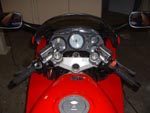
I recently put clipons from a VTR onto my 96 VFR 750. The VTR clipons are a bit lower and angled slightly differently with the end of the bars being more ‘down’.

Mounting them is fairly straightforward, but you do have to drill a small hole in the bar to get the right side switch gear to mount properly. Apparently the VTR switch gear has a mounting pin on the bottom switch gear housing whereas the VFR has its pin on the top housing. I drilled the index hole a bit farther, about 0.5 cm, down the bar (toward the end of the clipon) to make the throttle fit properly with my grips. In retrospect, it should have been more like 1 cm farther down.
With the VTR clipons being a bit lower that standard, it caused the brake lever and the clutch lever to push the dashboard at full lock. Full left caused the front brake lever to contact the dash and depress the lever, which could possibly cause inadvertent application of the front brake. To solve this problem I reduced the steering lock by epoxying some thin pieces of scrap aluminum to the steering lock nubs on the frame. This reduced my steering lock sufficiently to stop the brake or clutch levers from contacting the dash at full lock. The reduced steering lock shouldn’t be a problem since most sport bikes have lots less steering lock then the VFR. I made the aluminum scrap bits a bit longer than the frame nubs so that the scraps would be easy to break off should I want to go back to the original VFR clipons.
My riding impression of the VTR clipons is quite positive. The bike feels a bit heavier at standstill because the lowered clipons have less leverage to move the bike from side to side. At speed there is a bit more weight on your forearms, but still not even close to the forearm crunching levels that some sport bikes have. I feel like I can stretch my back our a bit which makes me more comfortable on the bike. At highway speeds (120-140 km/h) the slightly more leaned over position and makes the fairing much more effective and you don’t feel like the wind is pushing you off the back of the bike. The better angle of the bars makes a slight crouch quite comfortable, which makes highway miles a bit less stressful.
Doug Eleveld